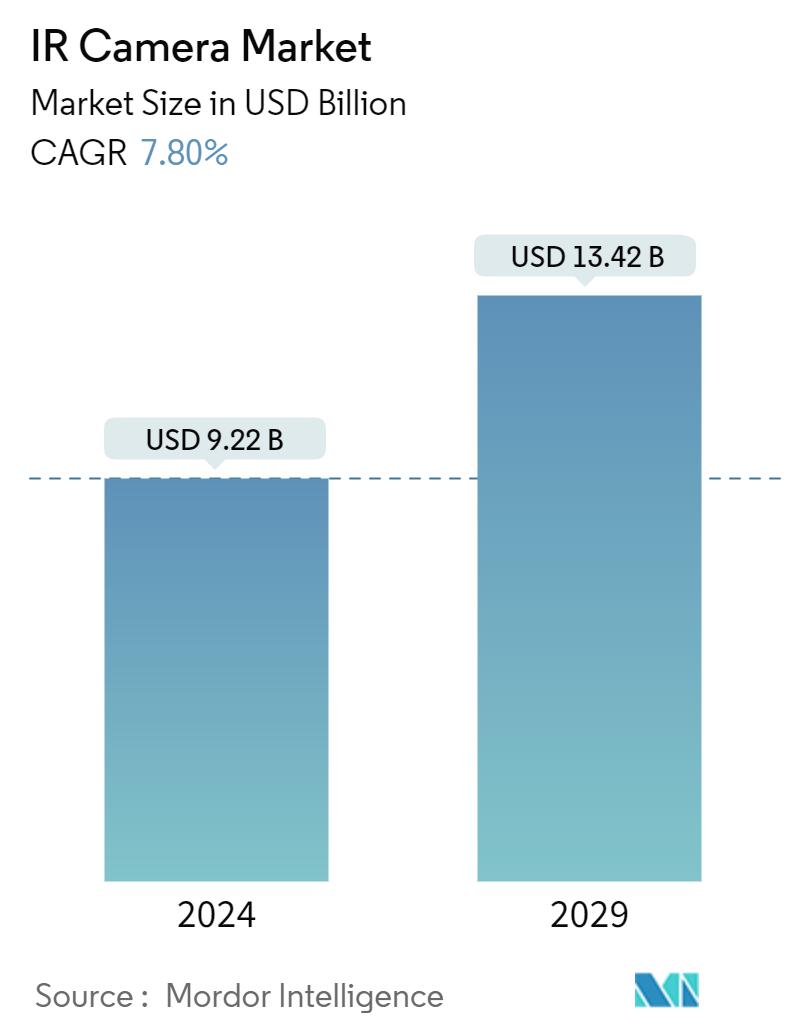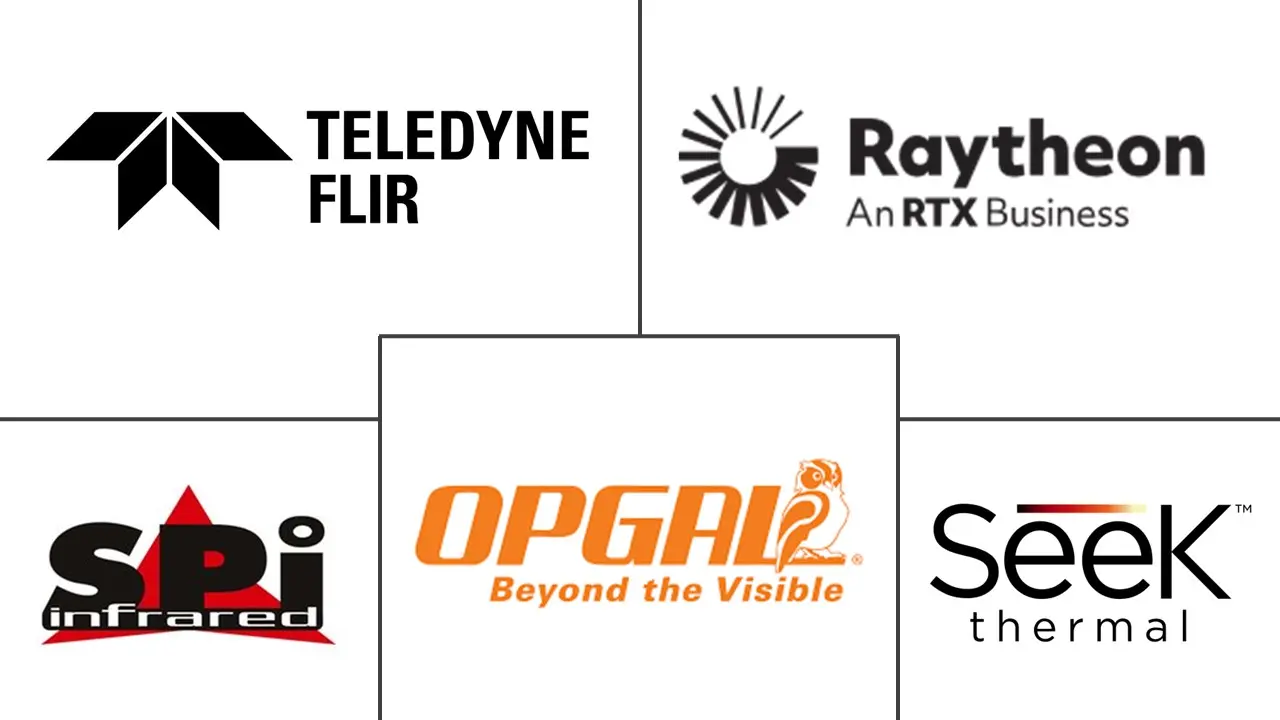
| Study Period | 2019 - 2029 |
| Market Size (2024) | USD 9.22 Billion |
| Market Size (2029) | USD 13.42 Billion |
| CAGR (2024 - 2029) | 7.80 % |
| Fastest Growing Market | Asia Pacific |
| Largest Market | Asia Pacific |
| Market Concentration | Low |
Major Players
*Disclaimer: Major Players sorted in no particular order |
IR Camera Market Analysis
The IR Camera Market size is estimated at USD 9.22 billion in 2024, and is expected to reach USD 13.42 billion by 2029, growing at a CAGR of 7.80% during the forecast period (2024-2029).
Infrared cameras are widely used for security and surveillance purposes. They can detect movement and capture thermal images even in complete darkness. This makes them suitable for monitoring large areas, identifying intruders, and preventing theft or vandalism.
- In addition, these cameras can be integrated with advanced video analytics to enhance threat detection and improve overall security measures. Some security cameras are equipped with smart IR technology. This technology modifies the brightness of the camera's infrared LEDs according to how far away an object is, avoiding the problem of the object being overly bright. It addresses the issue of images being washed out by infrared LEDs when objects are near the camera.
- Infrared cameras play a crucial role in energy audits and efficiency assessments. They allow users to identify areas of heat loss, insulation gaps, and building air leakage. By pinpointing these energy inefficiencies, infrared cameras enable users to make targeted improvements, reducing energy consumption and lowering utility bills. Moreover, these cameras aid in detecting faulty or inefficient equipment early, helping businesses optimize their energy usage.
- Infrared cameras are invaluable tools for preventive maintenance programs. By identifying abnormal heat patterns in electrical systems, mechanical equipment, and rotating machinery, these cameras can help detect potential failures before they occur. This proactive approach allows for timely repairs or replacements, minimizing downtime and preventing costly breakdowns. As a result, businesses can save money and improve overall operational efficiency. Infrared cameras are also extensively used for electrical inspections, as they can quickly identify overheating components and potential fire hazards.
- Infrared cameras have become essential tools for firefighters and rescue teams. These cameras can penetrate smoke and darkness to locate hotspots and identify potential victims during firefighting and search-and-rescue operations. Infrared cameras enhance situational awareness by providing real-time thermal imaging, enabling quicker and more effective response times.
- Infrared cameras have become increasingly popular in various industries due to their ability to capture thermal radiation. These cameras have found applications in fields such as security, building inspections, and even medical diagnostics. However, there are concerns regarding the accuracy of their functionality and the stringent import/export regulations governing their distribution.
IR Camera Industry Segmentation
The IR camera market is defined by the revenue generated from selling infrared cameras offered by different market players for a diverse range of end-user industries. The market trends are evaluated by analyzing the investments made in product innovation, diversification, and expansion. Further, the advancements in military & defense, automotive, and manufacturing sectors are also crucial in determining the market growth.
The IR camera market is segmented by the detector (cooled, uncooled), by material (germanium, silicon, sapphire, other materials), by type (near and short-wavelength IR, medium-wavelength IR, long-wavelength IR), by end-user vertical (military and defense, automotive, industrial, commercial and public, residential, and other end-user vertical), and by geography (North America [United States, Canada], Europe [United Kingdom, Germany, France, Rest of Europe], Asia-Pacific [China, India, Japan, Rest of Asia-Pacific], Rest of the World). The report offers market forecasts and size in value (USD) for all the above segments.
| Cooled |
| Uncooled |
| Germanium |
| Silicon |
| Sapphire |
| Other Materials |
| Near and Short-wavelength IR |
| Medium-wavelength IR |
| Long-wavelength IR |
| Military and Defense |
| Automotive |
| Industrial |
| Commercial and Public |
| Residential |
| Other End-user Vertical |
| North America | United States |
| Canada | |
| Europe | United Kingdom |
| Germany | |
| France | |
| Asia | China |
| India | |
| Japan | |
| Australia and New Zealand | |
| Latin America | |
| Middle East and Africa |
IR (Infrared) Camera Market Size Summary
The infrared (IR) camera market is experiencing significant growth, driven by its diverse applications across various industries. These cameras are essential for security and surveillance, capable of detecting movement and capturing thermal images in complete darkness, making them ideal for monitoring large areas and enhancing security measures. They are also crucial in energy audits, helping identify heat loss and insulation gaps, which aids in reducing energy consumption. In preventive maintenance, IR cameras detect abnormal heat patterns, allowing for timely repairs and minimizing downtime. Their applications extend to firefighting and rescue operations, where they enhance situational awareness by penetrating smoke and darkness. The automotive industry is increasingly adopting IR cameras for advanced driver-assistance systems (ADAS), improving safety features like night vision and object detection.
The Asia-Pacific region is witnessing a surge in demand for IR cameras, fueled by investments in automation and Industry 4.0 technologies. Countries like China and India are expanding their use of these cameras for security, ecological monitoring, and energy efficiency assessments. Japan's demand is driven by advancements in defense and healthcare applications. The market is highly fragmented, with major players like Teledyne FLIR LLC, SPI Corp., and Raytheon Company leading the way. Strategic collaborations and technological advancements, such as those between Valeo and Teledyne FLIR, are enhancing product offerings and driving market growth. The market's expansion is further supported by government policies promoting the adoption of ADAS and the growing popularity of autonomous vehicles.
IR (Infrared) Camera Market Size - Table of Contents
1. MARKET DYNAMICS
-
1.1 Market Drivers
- 1.1.1 Rising Demand for Surveillance Across Various Verticals
- 1.1.2 Gradually Decreasing Costs of Thermal Cameras
-
1.2 Market Challenges
- 1.2.1 Lack of Accuracy in Camera Functionality and Stringent Import/Export Regulations
2. MARKET SEGMENTATION
-
2.1 By Detector
- 2.1.1 Cooled
- 2.1.2 Uncooled
-
2.2 By Material
- 2.2.1 Germanium
- 2.2.2 Silicon
- 2.2.3 Sapphire
- 2.2.4 Other Materials
-
2.3 By Type
- 2.3.1 Near and Short-wavelength IR
- 2.3.2 Medium-wavelength IR
- 2.3.3 Long-wavelength IR
-
2.4 By End-user Vertical
- 2.4.1 Military and Defense
- 2.4.2 Automotive
- 2.4.3 Industrial
- 2.4.4 Commercial and Public
- 2.4.5 Residential
- 2.4.6 Other End-user Vertical
-
2.5 By Geography
- 2.5.1 North America
- 2.5.1.1 United States
- 2.5.1.2 Canada
- 2.5.2 Europe
- 2.5.2.1 United Kingdom
- 2.5.2.2 Germany
- 2.5.2.3 France
- 2.5.3 Asia
- 2.5.3.1 China
- 2.5.3.2 India
- 2.5.3.3 Japan
- 2.5.3.4 Australia and New Zealand
- 2.5.4 Latin America
- 2.5.5 Middle East and Africa
IR Camera Market Research FAQs
How big is the IR Camera Market?
The IR Camera Market size is expected to reach USD 9.22 billion in 2024 and grow at a CAGR of 7.80% to reach USD 13.42 billion by 2029.
What is the current IR Camera Market size?
In 2024, the IR Camera Market size is expected to reach USD 9.22 billion.


